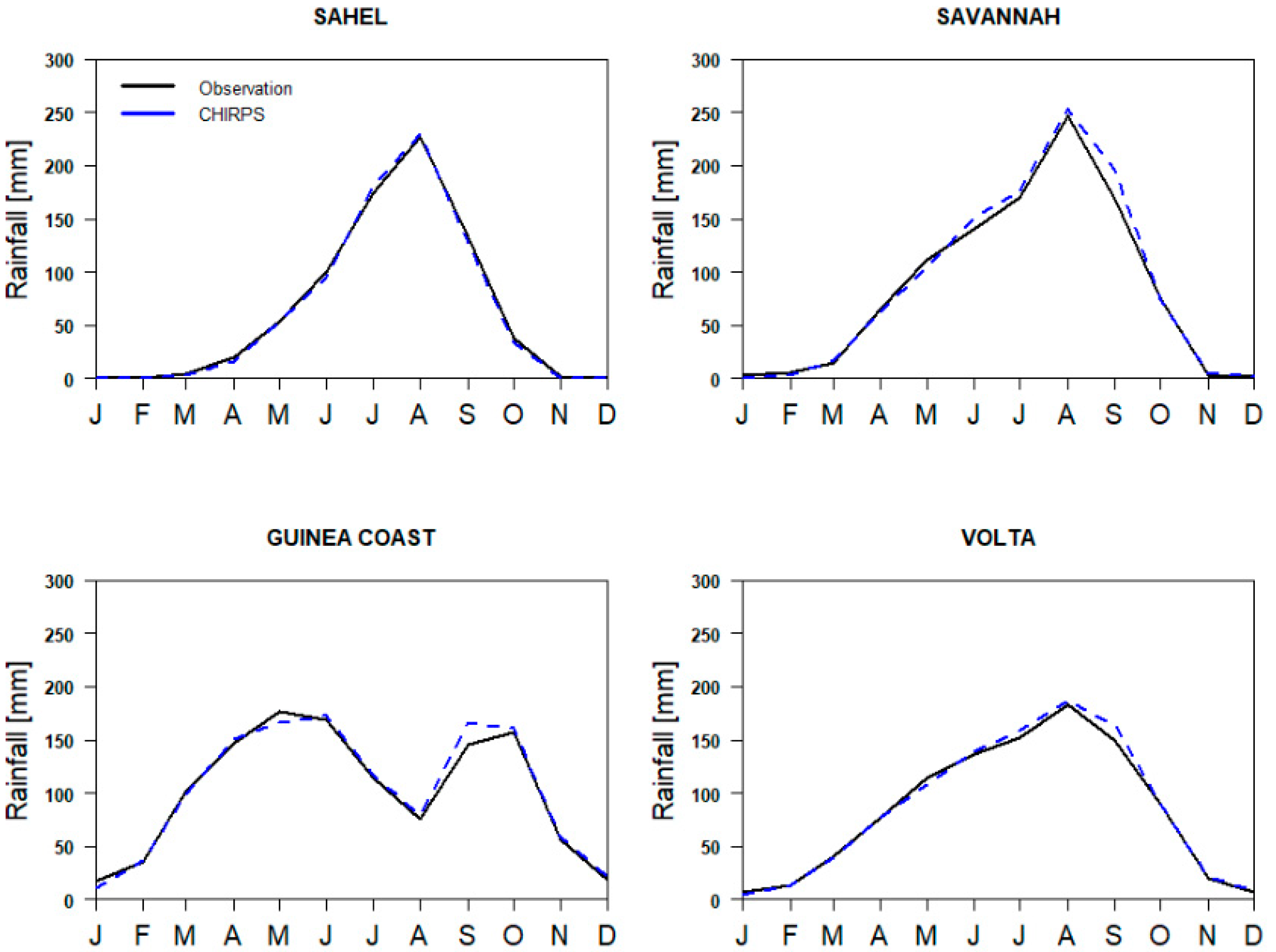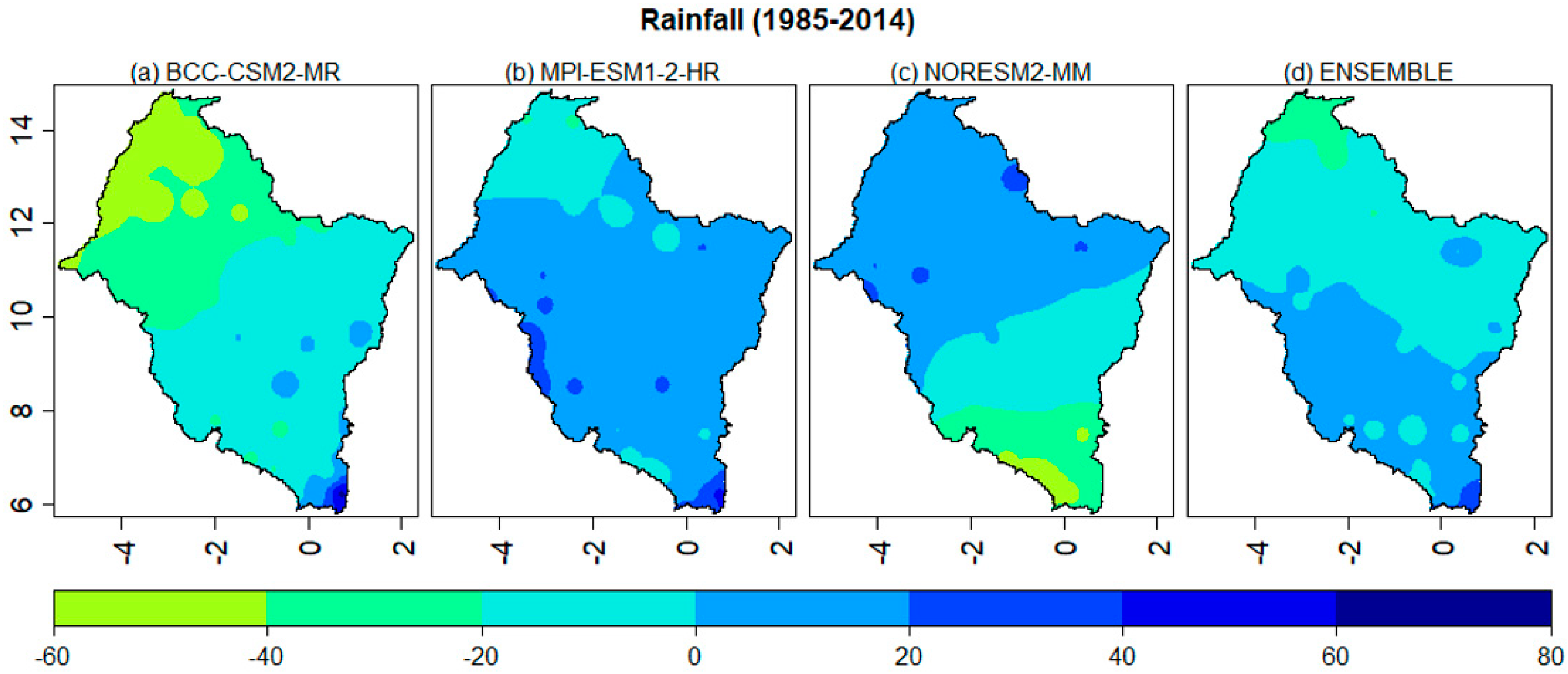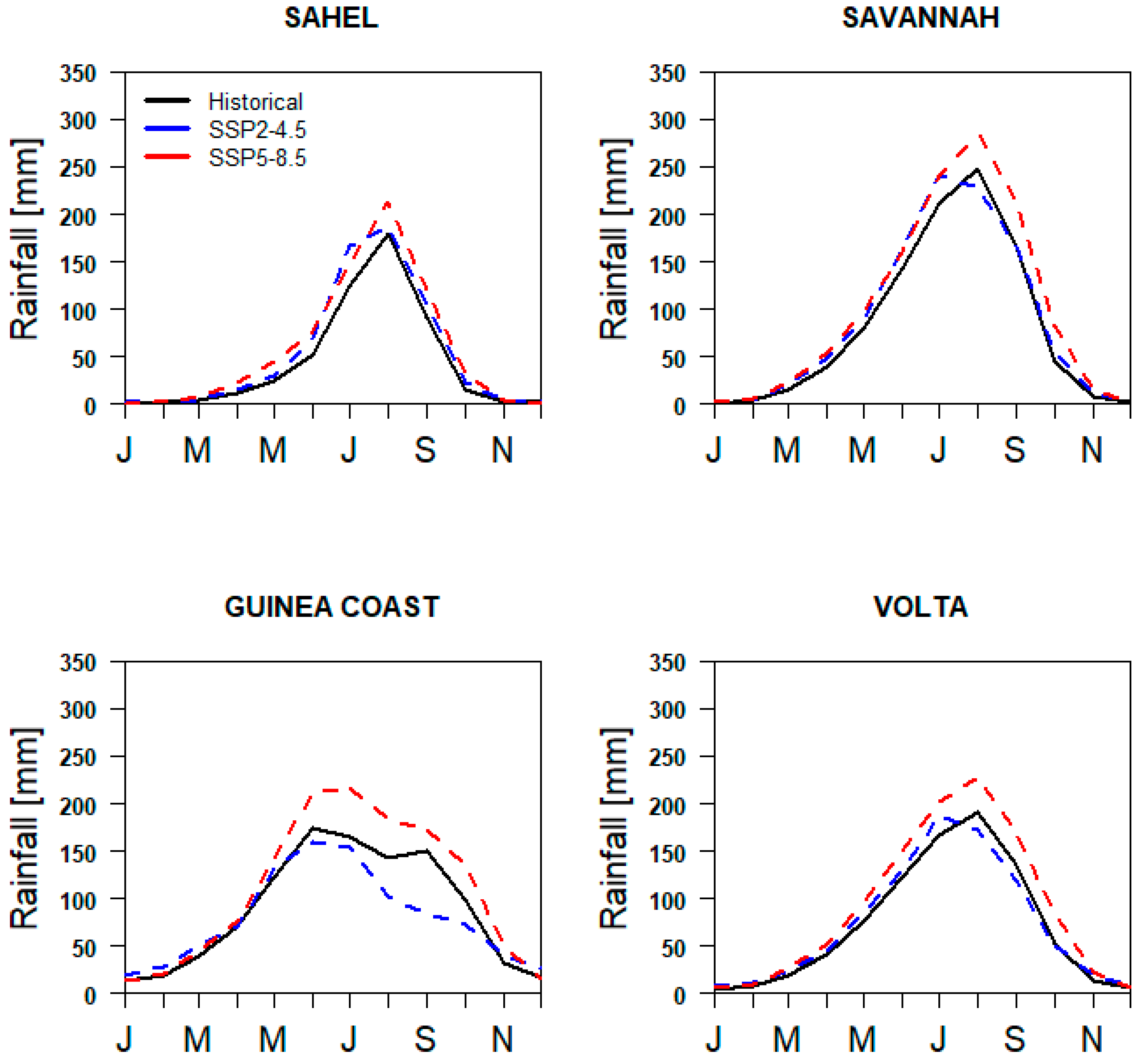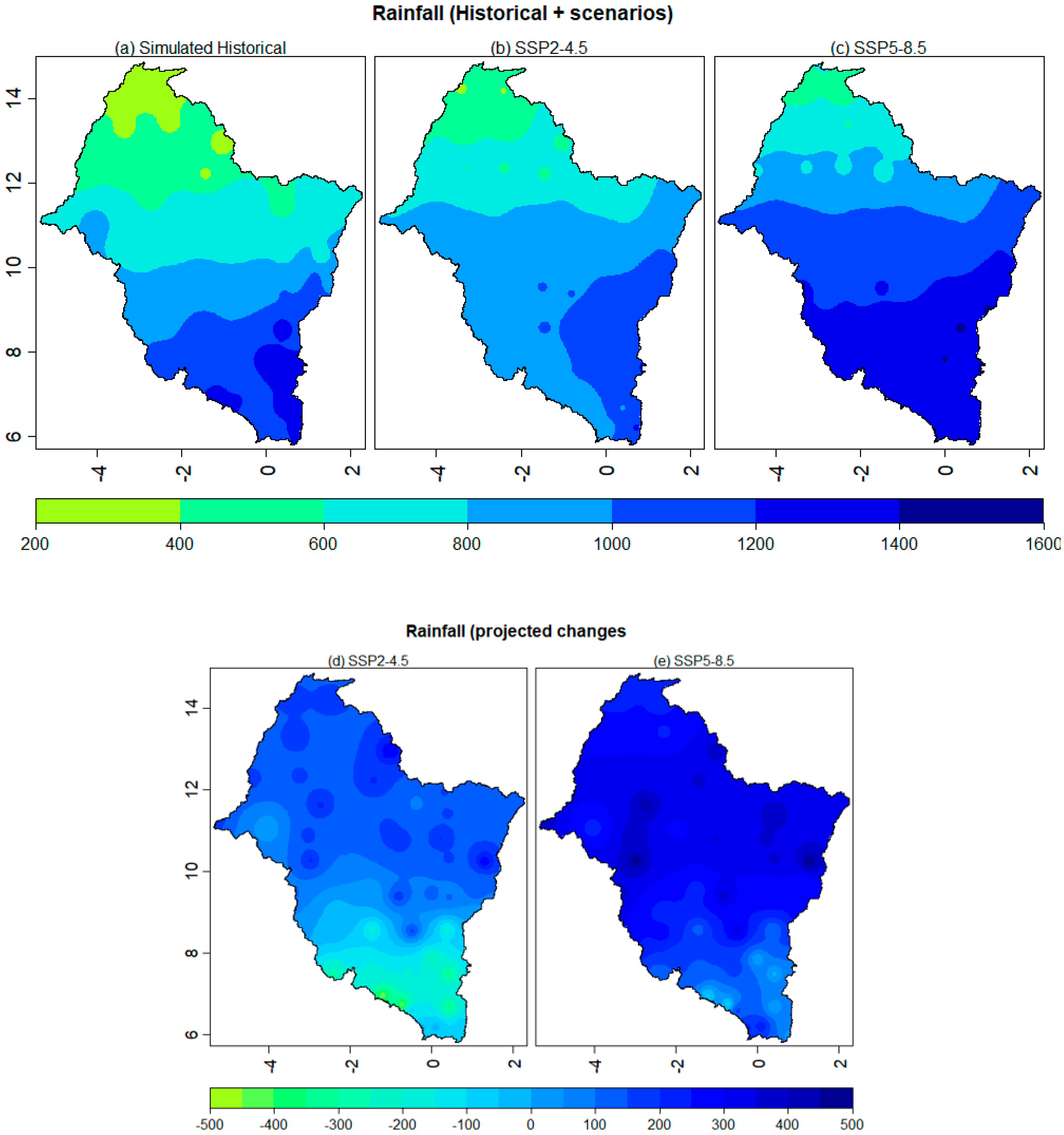Rainfall Projections from Coupled Model Intercomparison Project Phase 6 in the Volta River Basin: Implications on Achieving Sustainable Development
Abstract
:1. Introduction
2. Materials and Methods
2.1. Study Area Description
2.2. Observation and CMIP6 Models Data
2.3. Performance Evaluation of CMIP6 Models
2.4. Rainfall Changes, Trends and Uncertainty Analysis
3. Results
3.1. CMIP6 Models Perfomance Evaluation for Rainfall
3.1.1. Temporal Distribution
3.1.2. Spatial Biases in Rainfall Distribution
3.2. Rainfall Projections and Trends under SSP2-4.5 and SSP5-8.5 Scenarios
3.3. Projected Changes in Rainfall and Its Uncertainties Associated with the GCMs
4. Discussion
5. Conclusions
Author Contributions
Funding
Institutional Review Board Statement
Informed Consent Statement
Data Availability Statement
Acknowledgments
Conflicts of Interest
Appendix A

References
- Shiru, M.S.; Park, I. Comparison of Ensembles Projections of Rainfall from Four Bias Correction Methods over Nigeria. Water 2020, 12, 3044. [Google Scholar] [CrossRef]
- Sylla, M.B.; Elguindi, N.; Giorgi, F.; Wisser, D. Projected robust shift of climate zones over West Africa in response to anthropogenic climate change for the late 21st century. Clim. Chang. 2016, 134, 241–250. [Google Scholar] [CrossRef]
- Van Huijgevoort, M.; Van Lanen, H.; Teuling, A.; Uijlenhoet, R. Identification of changes in hydrological drought characteristics from a multi-GCM driven ensemble constrained by observed discharge. J. Hydrol. 2014, 512, 421–434. [Google Scholar] [CrossRef] [Green Version]
- Larbi, I.; Nyamekye, C.; Hountondji, F.C.C.; Okafor, G.C.; Odoom, P.E.R. Climate change impact on climate extremes and adaptation strategies in the Vea catchment, Ghana. In African Handbook of Climate Change Adaptation; Leal Filho, W., Ogugu, N., Adelake, L., Ayal, D., da Silva, I., Eds.; Springer Nature: Cham, Switzerland, 2021. [Google Scholar]
- Okafor, G.C.; Larbi, I.; Chukwumac, E.C.; Nyamekye, C.; Limantol, A.M.; Sam-Quarcoo, D. Local Climate Change Signals and Changes in Climate Extremes in the Dano Catchment, Burkina Faso. Environ. Chall. 2021, 5, 100285. [Google Scholar] [CrossRef]
- Mwabumba, M.; Yadav, B.K.; Rwiza, M.J.; Larbi, I.; Dotse, S.Q.; Limantol, A.M.; Kwawuvi, D. Rainfall and temperature changes under different climate scenarios at the watersheds surrounding the Ngorongoro Conservation Area in Tanzania. Environ. Chall. 2022, 7, 100446. [Google Scholar] [CrossRef]
- Herrero, M.; Ringler, C.; van de Steeg, J.; Thornton, P.; Zuo, T.; Bryan, E.; Omolo, A.; Koo, J.; Notenbaert, A. Climate Variability and Climate Change and Their Impacts on Kenya’s Agricultural Sector; ILR: Nairobi, Kenya, 2010. [Google Scholar]
- IPCC. Climate Change. The Physical Science Basis. Contribution of Working Group I to the Fifth Assessment Report of the Intergovernmental Panel on Climate Change; Cambridge University Press: Cambridge, UK; New York, NY, USA, 2013; pp. 1–1535. [Google Scholar]
- Environmental Protection Agency. Climate change and the Ghanaian economy. In Policy Advice Series; Environmental Protection Agency of Ghana: Accra, Ghana, 2017; Volume 1. [Google Scholar]
- Eyring, V.; Bony, S.; Meehl, G.A.; Senior, C.A.; Stevens, B.; Stoufer, R.J.; Taylor, K.E. Overview of the coupled model intercomparison project phase 6 (CMIP6) experimental design and organization. Geosci. Model. Dev. 2016, 9, 1937–1958. [Google Scholar] [CrossRef] [Green Version]
- Wang, D.; Liu, J.; Wang, H.; Shao, W.; Mei, C.; Ding, X. Performance evaluations of CMIP6 and CMIP5 models for precipitation simulation over the Hanjiang River Basin, China. J. Water Clim. Chang. 2022, 13, 2089–2106. [Google Scholar] [CrossRef]
- Jiang, D.; Hu, D.; Tian, Z.; Lang, X. Differences between CMIP6 and CMIP5 models in simulating climate over China and the East Asian monsoon. Adv. Atmos. Sci. 2020, 37, 1102–1118. [Google Scholar] [CrossRef]
- Agyekum, J.; Annor, T.; Lamptey, B.; Quansah, E.; Agyeman, R.Y.K. Evaluation of CMIP5 global climate models over the Volta Basin: Precipitation. Adv. Meteorol. 2018, 2018, 4853681. [Google Scholar] [CrossRef] [Green Version]
- Dembélé, M.; Vrac, M.; Ceperley, N.; Zwart, S.J.; Larsen, J.; Dadson, S.J.; Mariéthoz, G.; Schaefli, B. Contrasting changes in hydrological processes of the Volta River basin under global warming. Hydrol. Earth Syst. Sci. 2022, 26, 1481–1506. [Google Scholar] [CrossRef]
- Yeboah, K.A.; Akpoti, K.; Kabo-bah, A.T.; Ofosu, E.A.; Siabi, E.K.; Mortey, E.M.; Okyereh, S.A. Assessing climate change projections in the Volta Basin using the CORDEX-Africa climate simulations and statistical bias-correction. Environ. Chall. 2022, 6, 100439. [Google Scholar] [CrossRef]
- Ajibola, F.O.; Zhou, B.; Gnitou, G.T.; Onyejuruwa, A. Evaluation of the performance of CMIP6 HighResMIP on West African precipitation. Atmosphere 2020, 11, 1053. [Google Scholar] [CrossRef]
- Bizikova, L.; Robinson, J.B.; Cohen, S. Linking climate change and sustainable development at the local level. Clim. Policy 2007, 7, 271–277. [Google Scholar] [CrossRef]
- Haarsma, R.J.; Roberts, M.J.; Vidale, P.L.; Senior, C.A.; Bellucci, A.; Bao, Q.; Chang, P.; Corti, S.; Fučkar, N.S.; Guemas, V.; et al. High Resolution Model Intercomparison Project (HighResMIP v1.0) for CMIP6. Geosci. Model Dev. 2016, 9, 4185–4208. [Google Scholar] [CrossRef] [Green Version]
- WRC. Tano River Basin Integrated Water Resources Management Plan; Water Resources Commission (WRC): Accra, Ghana, 2012. [Google Scholar]
- Paeth, H.; Fink, A.H.; Pohle, S.; Keis, F.; Mächel, H.; Samimi, C. Meteorological characteristics and potential causes of the 2007 flood in sub-Saharan Africa. Int. J. Climatol. 2011, 31, 1908–1926. [Google Scholar] [CrossRef]
- Larbi, I.; Hountondji, F.C.C.; Annor, T.; Agyare, W.A.; Gathenya, J.M.; Amuzu, J. Spatio-Temporal Trend Analysis of Rainfall and Temperature Extremes in the Vea Catchment. Climate 2018, 6, 87. [Google Scholar] [CrossRef] [Green Version]
- Funk, C.; Peterson, P.; Landsfeld, M.; Pedreros, D.; Verdin, J.; Shukla, S.; Husak, G.; Rowland, J.; Harrison, L.; Hoell, A.; et al. The climate hazards infrared precipitation with stations—A new environmental record for monitoring extremes. Sci. Data 2015, 2, 150066. [Google Scholar] [CrossRef] [Green Version]
- Klutse, N.A.B.; Quagraine, K.A.; Nkrumah, F.; Quagraine, K.T.; Berkoh, O.R.; Dzrobi, J.F.; Sylla, M.B. The Climatic Analysis of Summer Monsoon Extreme Precipitation Events over West Africa in CMIP6 Simulations. Earth Syst. Environ. 2021, 5, 25–41. [Google Scholar] [CrossRef]
- Kumi, N.; Abiodun, B.J. Potential impacts of 1.5C and 2C global warming on rainfall onset, cessation and length of rainy season in West Africa. Environ. Res. Lett. 2018, 13, 055009. [Google Scholar] [CrossRef]
- Wu, T.; Lu, Y.; Fang, Y.; Xin, X.; Li, L.; Li, W.; Jie, W.; Zhang, J.; Liu, Y.; Zhang, L.; et al. The Beijing climate center climate system model (BCC-CSM): The main progress from CMIP5 to CMIP6. Geosci. Model. Dev. 2019, 12, 1573–1600. [Google Scholar] [CrossRef]
- Swart, N.C.; Cole, J.N.S.; Kharin, V.V.; Lazare, M.; Scinocca, J.F.; Gillett, N.P.; Anstey, J.; Arora, V.; Christian, J.R.; Hanna, S.; et al. The Canadian earth system model version 5 (CanESM5.0.3). Geosci. Model. Dev. 2019, 12, 4823–4873. [Google Scholar] [CrossRef] [Green Version]
- Gutjahr, O.; Putrasahan, D.; Lohmann, K.; Jungclaus, J.H.; Von Storch, J.S.; Brüggemann, N.; Haak, H.; Stössel, A. Max planck institute earth system model (MPI-ESM1.2) for the high-resolution model intercomparison project (HighResMIP). Geosci. Model. Dev. 2019, 12, 3241–3281. [Google Scholar] [CrossRef] [Green Version]
- Coupled Model Intercomparison Project Phase 6. Available online: https://esgf-node.llnl.gov/search/cmip6/ (accessed on 5 May 2021).
- Sood, A.; Smakhtin, V. Global hydrological models: A review. Hydrol. Sci. J. 2015, 60, 549–565. [Google Scholar] [CrossRef]
- Jain, S.; Salunke, P.; Mishra, S.K.; Sahany, S. Performance of CMIP5 models in the simulation of Indian summer monsoon. Theor. Appl. Climatol. 2019, 137, 1429–1447. [Google Scholar] [CrossRef]
- Li, J.; Heap, A.D. Spatial interpolation methods: A review for environmental scientists. Cartogr. Geogr. Inf. Sci. 2008, 10, 129–150. [Google Scholar]
- Chen, F.W.; Liu, C.W. Estimation of the spatial rainfall distribution using inverse distance weighting (IDW) in the middle of Taiwan. Paddy Water Environ. 2012, 10, 209–222. [Google Scholar] [CrossRef]
- Yiran, G.A.B.; Stringer, L.C. Spatio-temporal analyses of impacts of multiple climatic hazards in a savannah ecosystem of Ghana. Clim. Risk Manag. 2016, 14, 11–26. [Google Scholar] [CrossRef] [Green Version]
- Okafor, C.G.; Jimoh, O.D.; Larbi, I. Detecting Changes in Hydro-Climatic Variables during the Last Four Decades (1975–2014) on Downstream Kaduna River Catchment, Nigeria. Atmos. Clim. Sci. 2017, 7, 161–175. [Google Scholar] [CrossRef] [Green Version]
- Nyembo, L.O.; Larbi, I.; Mwemezi, J.R. Temporal and spatial climate variability and change in a shallow tropical lake of Tanzania. J. Water Clim. Change 2020, 12, 469–483. [Google Scholar] [CrossRef] [Green Version]
- Önöz, B.; Bayazit, M. The power of statistical tests for trend detection. Turk. J. Eng. Environ. Sci. 2003, 27, 247–251. [Google Scholar]
- Kim, J.; Duane, E.W.; Chris, A.M.; Cameron, E.G.; Andrew, F.H.; Paul, A.Z.; Daniel, J.C. Evaluation of the CORDEX-Africa multi-RCM hindcast: Systematic model errors. Clim. Dyn. 2020, 42, 1189–1202. [Google Scholar] [CrossRef]
- Asante, F.A.; Amuakwa-Mensah, F. Climate Change and Variability in Ghana: Stocktaking. Climate 2015, 3, 78–99. [Google Scholar] [CrossRef]
- Asare-Nuamah, P. Climate variability, subsistence agriculture and household food security in rural Ghana. Heliyon 2021, 7, e06928. [Google Scholar] [CrossRef] [PubMed]
- FAO. Fact Sheet: Smallholders and Family Farmers. 2012. Available online: http://www.fao.org/fileadmin/templates/nr/sustainability_pathways/docs/Factsheet_SMALLHOLDERS.pdf (accessed on 15 June 2021).
- Adeosun, O.T.; Asare-Nuamah, P.; Mabe, F.N. Vulnerability analysis of Nigeria’s agricultural output growth and climate change change. Manag. Environ. Qual. 2021, 32, 1352–1366. [Google Scholar] [CrossRef]
- Arndt, C.; Asante, F.; Thurlow, J. Implications of Climate Change for Ghana’s Economy. Sustainability 2015, 7, 7214–7231. [Google Scholar] [CrossRef] [Green Version]
- World Bank. Ghana Priorities for Ending Poverty and Boosting Shared Prosperity: Systematic Country Diagnostic; World Bank: Washington, DC, USA, 2018. [Google Scholar]
- World Bank. Poverty and Shared Prosperity 2018: Piecing Together the Poverty Puzzle; World Bank: Washington, DC, USA, 2018. [Google Scholar]
- Andah, W.E.I.; van de Giesen, N.; Biney, C.A. Water, Climate, Food, and Environment in the Volta Basin. 2013. Available online: http://www.weap21.org/downloads/ADAPTVolta.pdf (accessed on 30 June 2021).
- Ndehedehe, C.E.; Awange, J.L.; Kuhn, M.; Agutu, N.O.; Fukuda, Y. Analysis of hydrological variability over the Volta river basin using in-situ data and satellite observations. J. Hydrol. Reg. Stud. 2017, 12, 88–110. [Google Scholar]
- Stutley, C. Crop Insurance Feasibility Study. 2010. Available online: http://seguros.riesgoycambioclimatico.org/DocInteres/eng/Ghana-Crop-Insurance.pdf (accessed on 14 October 2021).
- Wossen, T.; Berger, T.; Haile, M.G.; Troost, C. Impacts of climate variability and food price volatility on household income and food security of farm households in East and West Africa. Agric. Syst. 2018, 163, 7–15. [Google Scholar] [CrossRef]
- Kabo-Bah, A.; Diji, C.; Nokoe, K.; Mulugetta, Y.; Obeng-Ofori, D.; Akpoti, K. Multiyear Rainfall and Temperature Trends in the Volta River Basin and their Potential Impact on Hydropower Generation in Ghana. Climate 2016, 4, 49. [Google Scholar] [CrossRef]









| Model | Institute | Reference |
|---|---|---|
| BCC-CSM2-MR | Beijing Climate Centre (BCC) and China Meteorological Administration (CMA), China | Wu et al. [25] |
| NorESM2-MM | Norwegian Climate Centre, Norway | Swart et al. [26] |
| MPI-ESM1-2-HR | Max Planck Institute, Germany | Gutjahr et al. [27] |
| Zones | Historical | SSP2-4.5 | SSP5-8.5 |
|---|---|---|---|
| Sahel | 508.9 | 539.2 (+6.0) | 674.4 (+32.5) * |
| Savannah | 962.7 | 1033.2 (+7.3) | 1182.2 (+22.8) * |
| Coastal | 1043.5 | 1031.5 (−1.1) | 1283.7 (+23.0) * |
| Volta | 838.4 | 860.2 (+2.6) | 1046.9 (+24.9) * |
| Zones | CMIP 6 Historical+ SSP2-4.5 (1985–2050) | CMIP 6 Historical+ SSP4-8.5 (1985–2050) | ||
|---|---|---|---|---|
| Z | Q | Z | Q | |
| Sahel | 3.88 ** | 2.1 | 5.93 ** | 3.8 |
| Savannah | 2.56 ** | 1.5 | 5.91 ** | 4.9 |
| Coastal | −3.08 ** | −3.0 | 5.38 ** | 4.9 |
| Volta Basin | 0.38 | 0.20 | 5.93 ** | 4.4 |
Disclaimer/Publisher’s Note: The statements, opinions and data contained in all publications are solely those of the individual author(s) and contributor(s) and not of MDPI and/or the editor(s). MDPI and/or the editor(s) disclaim responsibility for any injury to people or property resulting from any ideas, methods, instructions or products referred to in the content. |
© 2023 by the authors. Licensee MDPI, Basel, Switzerland. This article is an open access article distributed under the terms and conditions of the Creative Commons Attribution (CC BY) license (https://creativecommons.org/licenses/by/4.0/).
Share and Cite
Dotse, S.-Q.; Larbi, I.; Limantol, A.M.; Asare-Nuamah, P.; Frimpong, L.K.; Alhassan, A.-R.M.; Sarpong, S.; Angmor, E.; Ayisi-Addo, A.K. Rainfall Projections from Coupled Model Intercomparison Project Phase 6 in the Volta River Basin: Implications on Achieving Sustainable Development. Sustainability 2023, 15, 1472. https://doi.org/10.3390/su15021472
Dotse S-Q, Larbi I, Limantol AM, Asare-Nuamah P, Frimpong LK, Alhassan A-RM, Sarpong S, Angmor E, Ayisi-Addo AK. Rainfall Projections from Coupled Model Intercomparison Project Phase 6 in the Volta River Basin: Implications on Achieving Sustainable Development. Sustainability. 2023; 15(2):1472. https://doi.org/10.3390/su15021472
Chicago/Turabian StyleDotse, Sam-Quarcoo, Isaac Larbi, Andrew Manoba Limantol, Peter Asare-Nuamah, Louis Kusi Frimpong, Abdul-Rauf Malimanga Alhassan, Solomon Sarpong, Emmanuel Angmor, and Angela Kyerewaa Ayisi-Addo. 2023. "Rainfall Projections from Coupled Model Intercomparison Project Phase 6 in the Volta River Basin: Implications on Achieving Sustainable Development" Sustainability 15, no. 2: 1472. https://doi.org/10.3390/su15021472
APA StyleDotse, S.-Q., Larbi, I., Limantol, A. M., Asare-Nuamah, P., Frimpong, L. K., Alhassan, A.-R. M., Sarpong, S., Angmor, E., & Ayisi-Addo, A. K. (2023). Rainfall Projections from Coupled Model Intercomparison Project Phase 6 in the Volta River Basin: Implications on Achieving Sustainable Development. Sustainability, 15(2), 1472. https://doi.org/10.3390/su15021472





